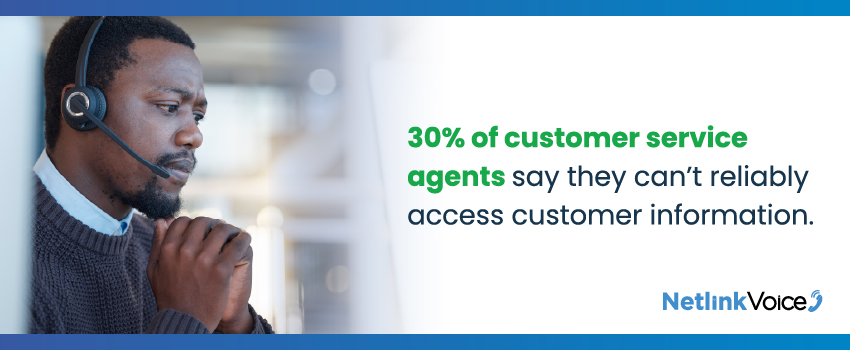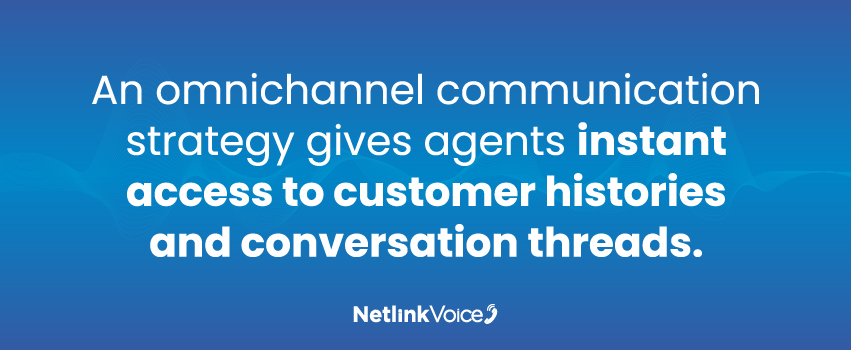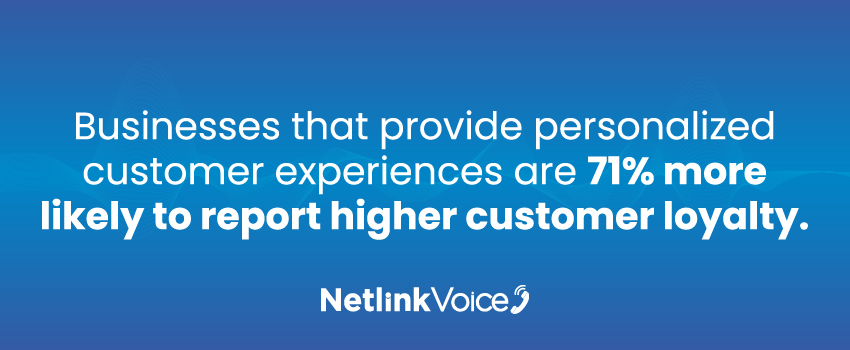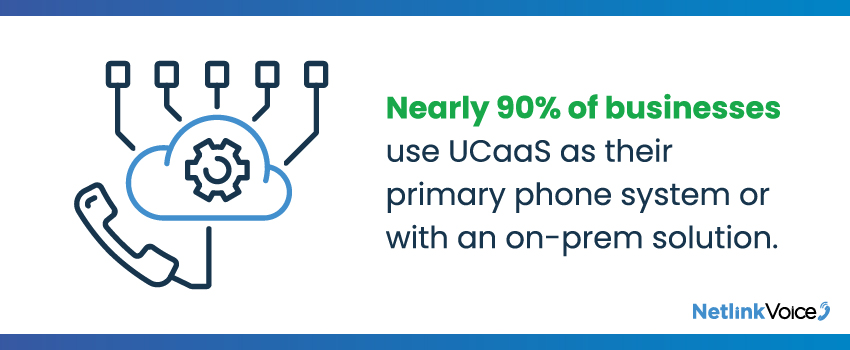Customers expect a smooth, consistent experience when they interact with businesses – and over 50% of consumers will switch to a competitor if they don’t receive it.1 Omnichannel communication helps organizations deliver excellent service across every touchpoint, ensuring customers feel understood and valued regardless of how they connect with your company.
But what is omnichannel communication, and why is it so important for modern businesses? In this blog, we’ll break down the essentials and explore its benefits, strategies, and role in customer service.
What Is Omnichannel Communication?
Understanding omnichannel communication starts with recognizing how it differs from traditional customer service approaches. Many businesses offer multiple disconnected channels for customers to get in touch, which could be why 30% of agents say they can’t reliably access customer information.1 True omnichannel communication ensures conversations flow naturally between different methods of contact.
For example, a customer might start an interaction on your website’s live chat, follow up with a phone call, and complete the transaction via email. With omnichannel communication, all these touchpoints are integrated, so the customer doesn’t have to repeat their concerns or re-explain their issue at every stage.

Key Features of Omnichannel Communication
A successful omnichannel communication strategy should include the following features:
- Channel Integration: Seamless connectivity between channels like voice, email, and instant messaging ensures consistent communication across platforms.
- Unified Customer Data: All customer interactions are stored and accessible, creating a single view of the customer’s journey.
- Real-Time Updates: Changes made on one channel are immediately reflected across all others to ensure continuity.
- Accessibility: Customers can interact on their preferred channel at their preferred time, with no loss of context.
These features work together to create a communication system that gives customers and employees clearer, more efficient customer service experiences.
Why Is Omnichannel Communication Important?
The importance of omnichannel communication extends beyond simple customer convenience. When implemented effectively, it creates lasting benefits for both businesses and their customers, improving everything from daily interactions to long-term relationship building.
Some of the biggest advantages of implementing an omnichannel customer service strategy include:
Enhanced Customer Experiences
Customers feel valued when they can have natural conversations across different channels without repeating themselves. The seamless flow between chat, phone, email, and social media creates a sense of continuity that makes complex problems easier to solve.
Increased Efficiency
A unified communication system gives your team instant access to customer histories and conversation threads. This comprehensive view helps them solve problems faster and more accurately than ever before. Plus, these systems include automated processes to handle routine tasks so your team can focus on providing personalized service where it matters most.

Higher Customer Retention
When customers receive consistent, high-quality service across all channels, they’re more likely to stay loyal to your business. The foundation of strong customer relationships lies in making every interaction count, as these positive experiences add up over time to create lasting connections between customers and your brand.
Better Insights and Analytics
Data from your communication channels reveals patterns in customer behavior and preferences, which can help you understand what your customers need and how they prefer to interact with your business. You can use this knowledge to fine-tune your service approach and build more meaningful connections with your audience.
How Omnichannel Communication Transforms Customer Service
Effective omnichannel customer service creates a cohesive experience that reflects the customer’s journey. This approach creates opportunities for deeper engagement and more meaningful interactions – no matter how customers interact with your brand.
Faster Issue Resolution
An omnichannel customer service strategy lets team members jump into any conversation with full context about previous interactions, making problem-solving much more efficient. This instant access to information means customers spend less time explaining their situation and more time getting the help they need.
The ability to switch between communication channels also helps customer service reps resolve complex issues more effectively. A conversation that starts in chat can easily move to a phone call if needed – and since the context of the conversation follows each channel, there’s no loss of momentum.
Support Across Multiple Platforms
Customers appreciate having choices in how they communicate with your business. Some prefer interacting with social media messages, while others value email exchanges or real-time phone conversations.
Omnichannel communication enables your team to maintain consistent service quality across all these platforms, ensuring customers receive the same level of attention and care regardless of how they get in touch.
Personalization at Every Touchpoint
A 2024 survey found that businesses that provide personalized customer experiences are 71% more likely to report higher customer loyalty.2 Modern omnichannel communication platforms enable service representatives to offer relevant suggestions based on previous purchases and conversations.
Plus, each interaction becomes more meaningful when you understand your customer’s complete history with your business. Your team can greet customers by name and immediately understand their preferences, so conversations feel more personal.

4 Steps for Implementing Omnichannel Communication
So, how do businesses create an effective omnichannel customer service strategy? Here are some essential steps:
1. Invest in the Right Technology
Unified communication platforms form the backbone of any omnichannel communication strategy. Look for features like:
- Centralized data management
- Automation capabilities
- Mobile accessibility options
- Advanced security features
- Integrations with your existing tools
- Cross-channel reporting and analytics
The right technology foundation makes it easier for your team to provide excellent service while keeping customer data secure and accessible.
2. Train Your Team
Your team’s ability to use your omnichannel tools effectively will determine the success of your implementation. Providing a training program ensures everyone understands both the technology and the principles behind excellent customer service. Training sessions might include:
- Comprehensive onboarding materials
- Common customer scenarios
- Successful interaction examples
- Clear communication guidelines
- Ongoing coaching and support
Well-trained team members feel confident using new tools and providing consistent service across all channels.
3. Optimize Communication Channels
Each communication channel needs careful configuration and ongoing maintenance to perform at its best. Optimize your channels by:
- Testing on different devices
- Automating responses to common questions
- Offering clear escalation paths
- Monitoring channel performance metrics
- Asking for feedback
- Establishing quality control measures
Regular optimization ensures each channel performs at its best and meets customer expectations.
4. Monitor and Adjust
Continuous improvement relies on careful monitoring and thoughtful adjustments to your omnichannel strategy. Regular assessment can help you identify what’s working well and where you might need changes. Focus on tracking:
- Key performance indicators
- Channel usage patterns
- Response times
- Customer satisfaction scores
Monitoring these metrics can help you pinpoint areas for improvement and make adjustments to keep your communications effective.

Benefits of UCaaS for Omnichannel Communication
A unified communications as a service (UCaaS) platform is a must-have for businesses that want to implement an omnichannel strategy, which is likely why nearly 90% of organizations already use UCaaS as their primary phone system or with an on-prem solution.3
UCaaS combines channels like voice, video, and messaging into one cloud-based system, ensuring all communication channels are integrated and accessible. These systems offer businesses benefits like:
- Centralized Management: UCaaS lets you manage all communication channels from a single interface, simplifying workflows and improving efficiency.
- Seamless Integration: UCaaS platforms integrate with customer relationship management (CRM) systems and other tools to offer a unified view of customer interactions.
- Enhanced Mobility: Since UCaaS is based in the cloud, employees can manage customer interactions and provide consistent service regardless of location.
- Scalability: UCaaS solutions let organizations easily add or adjust channels as your business grows, ensuring your communication strategy adapts to customer demands.
- Improved Collaboration: With UCaaS, employees can collaborate across departments in real time, enhancing teamwork and ensuring quick responses to customer inquiries.
Ultimately, the right UCaaS platform can help your team work more efficiently while providing better experiences for your customers, leading to stronger relationships and increased satisfaction.
Transform Your Omnichannel Communication Strategy With Netlink Voice
Implementing an effective omnichannel communication strategy can be the difference between good and exceptional customer service. When all your communication channels work together seamlessly, you create experiences that keep customers coming back for more.
At Netlink Voice, we know today’s businesses need more than traditional communication tools. That’s why we designed our ConnectWare UCaaS platform to bring together voice, text, chat, and video in one integrated system – accessible from any device, anywhere. Unlike one-size-fits-all providers, we’re here to help you create a solution tailored to your needs.
Ready to elevate your communication strategy? Contact us today to learn more about ConnectWare.
Sources:

